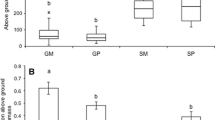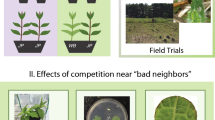Abstract
Plant patch structure and environmental context can influence the outcome of antagonistic and mutualistic plant–insect interactions, leading to spatially variable fitness effects for plants. We investigated the effects of herbivory and pollen limitation on plant reproductive performance in 28 patches of the self-compatible perennial herb Scrophularia nodosa and assessed how such effects varied with plant patch size, plant density and tree cover. Both antagonistic and mutualistic interactions had strong effects on plant reproductive performance. Leaf feeding from herbivores reduced both fruit production and seed germination, and leaf herbivory increased with plant patch size. Experimentally hand-pollinated flowers produced more seeds than open-pollinated flowers, and pollen limitation was more severe in patches with fewer plants. Our study on S. nodosa is one of few which documents that plant patch structure influences the outcome of both antagonistic and mutualistic plant–insect interactions. The results thus provide an example of how variation in plant patch structure and environmental factors can lead to spatially variable fitness effects from mutualistic and antagonistic interactions.




Similar content being viewed by others
References
Ågren J (1996) Population size, pollinator limitation and seed set in the self-incompatible herb Lythrum salicaria. Ecology 77:1779–1790
Aguilar R, Ashworth L, Galetto L, Aizen MA (2006) Plant reproductive susceptibility to habitat fragmentation: review and synthesis through a meta-analysis. Ecol Lett 9:968–980
Andersson P, Hambäck PA (2011) Immigration of olfactory searching insects into host plant patches: testing scaling rules for olfactory information. APIS 5:269–277
Andersson P, Hambäck PA (2012) What shapes local density? The importance of migration rates and local growth for density-patch size relationships in two Cionus weevils. Ecol Entomol 37:90–98
Arvanitis L, Wiklund C, Ehrlén J (2007) Butterfly seed predation: effects of landscape characteristics, plant ploidy level and population structure. Oecologia (Heidelb) 152:275–285
Bates D, Maechler M, Bolker B, Walker S (2014) Linear mixed-effects models using Eigen and S4. J Stat Softw 67(1):1–48. doi:10.18637/jss.v067.i01
Brodmann J, Emer D, Ayasse M (2012) Pollinator attraction of the wasp-flower Scrophularia umbrosa (Scrophulariaceae). Plant Biology 14:500–505
Dauber J, Biesmeijer JC, Gabriel D, Kunin WE, Lamborn E, Meyer B, Nielsen A, Potts SG, Roberts SPM, Sober V, Settele J, Steffan-Dewenter I, Stout JC, Teder T, Tscheulin T, Vivarelli D, Petanidou T (2010) Effects of patch size and density on flower visitation and seed set of wild plants: a pan-European approach. J Ecol 98:188–196
Devos OC (1983) Scrophularia nodosa, adapted to wasp pollination. Acta Bot Neerl 32:345
Diekotter T, Haynes KJ, Mazeffa D, Crist TO (2007) Direct and indirect effects of habitat area and matrix composition on species interactions among flower-visiting insects. Oikos 116:1588–1598
Dukas R (2008) Evolutionary biology of insect learning. Annu Rev Entomol 53:145–160
Elzinga JA, Turin H, van Damme JMM, Biere A (2005) Plant population size and isolation affect herbivory of Silene latifolia by the specialist herbivore Hadena bicruris and parasitism of the herbivore by parasitoids. Oecologia (Heidelb) 144:416–426
Englund G, Hambäck PA (2007) Scale dependence of immigration rates: models, metrics, and data. J Anim Ecol 76:30–35
Feldman TS (2006) Pollinator aggregative and functional responses to flower density: does pollinator response to patches of plants accelerate at low-densities? Oikos 115:128–140
Fournier DA, Skaug HJ, Ancheta J, Ianelli J, Magnusson A, Maunder MN, Nielsen A, Sibert J (2012) AD Model Builder: using automatic differentiation for statistical inference of highly parameterized complex nonlinear models. Optim Methods Softw 27:233–249
Gonzalez-Varo JP, Arroyo J, Aparicio A (2009) Effects of fragmentation on pollinator assemblage, pollen limitation and seed production of Mediterranean myrtle (Myrtus communis). Biol Conserv 142:1058–1065
Goulson D (2000) Why do pollinators visit proportionally fewer flowers in large patches? Oikos 91:485–492
Hambäck PA, Englund G (2005) Patch area, population density and the scaling of migration rates: the resource concentration hypothesis revisited. Ecol Lett 8:1057–1065
Hambäck PA, Dahlgren JP, Andersson P, Rabasa SG, Bommarco R, Ehrlén J (2011) Plant trait-mediated interactions between early and late herbivores on common figwort (Scrophularia nodosa) and effects on plant seed set. Ecoscience 18:375–381
Jakobsson A, Lazaro A, Totland O (2009) Relationships between the floral neighborhood and individual pollen limitation in two self-incompatible herbs. Oecologia (Heidelb) 160:707–719
Knight TM, Steets JA, Ashman TL (2006) A quantitative synthesis of pollen supplementation experiments highlights the contribution of resource reallocation to estimates of pollen limitation. Am J Bot 93:271–277
Kolb A, Leimu R, Ehrlén J (2007) Environmental context influences the outcome of a plant-seed predator interaction. Oikos 116:864–872
Kunin WE (1999) Patterns of herbivore incidence on experimental arrays and field populations of ragwort, Senecio jacobaea. Oikos 84:515–525
Lagerberg T (1938) Vilda växter i norden. vol. 4. Natur och Kultur, Stockholm
Lazaro A, Totland O (2010) Local floral composition and the behaviour of pollinators: attraction to and foraging within experimental patches. Ecol Entomol 35:652–661
Lihoreau M, Chittka L, Raine NE (2011) Trade-off between travel distance and prioritization of high-reward sites in traplining bumblebees. Funct Ecol 25:1284–1292
Morris MG (1991) Weevils. Richmond Publ. Co. Sleugh
Morris WF, Hufbauer RA, Agrawal AA, Bever JD, Borowicz VA, Gilbert GS, Maron JL, Mitchell CE, Parker IM, Power AG, Torchin ME, Vazquez DP (2007) Direct and interactive effects of enemies and mutualists on plant performance: a meta-analysis. Ecology 88:1021–1029
R Core Team (2014) R: A language and environment for statistical computing. R Foundation for Statistical Computing, Vienna, Austria. ISBN 3-900051-07-0. http://www.R-project.org
Root RB (1973) Organization of a plant-arthropod association in simple and diverse habitats: the fauna of collards (Brassica oleracea). Ecol Monogr 43:95–124
Rosenberg DK, Noon BR, Meslow EC (1997) Biological corridors: form, function, and efficacy. Bioscience 47:677–687
Sih A, Baltus MS (1987) Patch size, pollinator behavior, and pollinator limitation in catnip. Ecology 68:1679–1690
Stout JC, Allen JA, Goulson D (1998) The influence of relative plant density and floral morphological complexity on the behaviour of bumblebees. Oecologia (Heidelb) 117:543–550
Thompson JN (2005) Coevolution: the geographic mosaic of coevolutionary arms races. Curr Biol 15:R992–R994
Waddington KD, Holden LR (1979) Optimal foraging—flower selection by bees. Am Nat 114:179–196
Ward M, Johnson SD, Zalucki MP (2013) When bigger is not better: intraspecific competition for pollination increases with population size in invasive milkweeds. Oecologia (Heidelb) 171:883–891
Zuur AF, Hilbe JM, Ieno EN (2014) Beginner’s guide to GLM and GLMM with R. Highland Statistics Ltd, Newburgh
Acknowledgments
We thank Cecilia Lind Lindkvist for field assistance and Johanne Ericson, Caroline Essenberg and Tove Porseryd for lab assistance. We also thank Steven D. Johnson for helpful comments on earlier versions of the manuscript. The experiments comply with the current laws of the country Sweden in which the experiments were performed.
Author contribution statement
PA, JE and PAH conceived and designed the experiments. PA performed experiments and collected data. PA and PAH analysed the data. PA, JE, and PAH wrote the manuscript.
Author information
Authors and Affiliations
Corresponding author
Additional information
Communicated by Katherine L. Gross.
Rights and permissions
About this article
Cite this article
Andersson, P., Ehrlén, J. & Hambäck, P.A. Plant patch structure influences plant fitness via antagonistic and mutualistic interactions but in different directions. Oecologia 180, 1175–1182 (2016). https://doi.org/10.1007/s00442-015-3532-y
Received:
Accepted:
Published:
Issue Date:
DOI: https://doi.org/10.1007/s00442-015-3532-y




